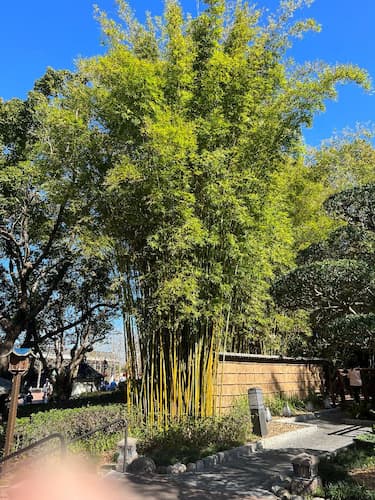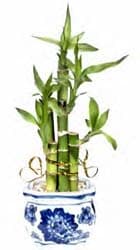How to Grow Bamboo Houseplants

About Bamboo Plants
In this article, we talk about how to grow bamboo as a houseplant. Surprisingly, Scientists classify bamboo as a grass. Among the thousands of varieties, there are hardwoods and softwoods. The tallest variety grows about 130 feet tall, making bamboo the tallest grass in the world! Some hardwood varieties are so hard, that they are used as wood. For example, bamboo floors have become popular. Bamboo is also used in scaffolding in Asia. Many varieties live hundreds of years.
With that said, Americans most often grow Bamboo as a houseplant. Its popularity as a houseplant is growing steadily. It is easy to grow, requires little attention, and thrives in almost any light. Native to China, Bamboo is the favorite food of Giant Panda Bears.
Did You Know? In addition to Pandas, some Lemurs, gorillas, and chimpanzees include bamboo on their diet.
When grown indoors as houseplants, bamboo is planted in containers filled with decorative stones. Just add water ……………… and you have a beautiful, greenhouse plant.
You can also grow bamboo indoors in soil. Plants grown in soil will grow faster and larger, than plants grown in water.
Bamboo is a lucky symbol, bringing you good fortune. This is a major reason for its popularity. It is most notably a symbol of being lucky in love.
Bamboo Plant Specifications
Flowers Bloom: Once in a lifetime. The plant usually dies after blooming.
Plant Height: From just six inches to over 130 feet tall, depending upon variety.
Lifespan:30 to 130 years, depending upon species.
Light Requirements: At least six to eight hours of bright, direct or indirect sunlight.
Humidity: Normal to high humidity.
Hardiness Zones: 6 – 9
Toxic?: Yes and no.
Number of Species: There are over 1,200 species of bamboo.
Ideal Soil pH: 5.5 – 6.5.
Native To: China, Vietnam, and Southeast Asia.
Plant Type: Perennial
Plant Botanical Name: Bambuseae
Is Bamboo Edible?
YES and NO!!
Fresh bamboo contains the toxin Hydrogen Cyanide which can make you very sick. And, if you eat enough, it is deadly. It is also potentially deadly to pets. However, panda bears are immune from the effects of this toxin. Their gastrointestinal system breaks the toxin down into a harmless (for them) chemical.
Of approximately 1,200 species, only 110 are edible. To make them edible, they are boiled in water. The deadly chemical breaks down in the boiling water.
Important: We strongly recommend you do not cook bamboo yourself for consumption. Rather, buy it at the store. The manufacturer has properly prepared it for human consumption.
Medicinal Benefits of Bamboo Plant
Despite most bamboo plants being toxic to humans, they have some medicinal applications. Here are some of them:
- Bamboo plants are loaded with vitamins and minerals.
- It has anti-inflammatory uses.
- Bamboo contains antioxidant properties.
- Supports and boosts the immune system.
- It lowers your bad LDL Cholesterol.
- Aids in heart health.
- Prevents constipation.
- It promotes digestive health.
Caution: As previously mentioned, bamboo plants are poisonous. We strongly recommend you do not make a home remedy yourself from this plant unless you are trained to do so by a qualified professional.
Light Requirements
Light requirements for Bamboo plants vary by variety. As a rule of thumb provide the plants with six to eight houses of bright direct, or indirect sunlight. Taller varieties are likely to receive full sunlight all day long. Meanwhile, shorter varieties usually do better with less light or with indirect light. For indoor plants, grow them in indirect light. Over time, they adapt to this level of lighting.
It is possible to give some varieties too much light. the stalks will begin to turn white.

Bamboo House Plant Propagation
Bamboo plants can be grown from cuttings. Select healthy, vigorous, young canes. They root readily in water. Just place them in a jar or glass with an inch of water.
Once your plants are established you can rot more cuttings for all of your gardening friends.
Also, they are propagated from Rhizomes. Plant the rhizomes in large containers. Plant them 1 to 2 inches deep. The basic varieties are categorized as clumping or running which describes the plant growth habit. Clumping varieties are best for indoor houseplants.
Panda Bear Trivia: Baby giant pandas are born pink and blind. They open their eyes and see about six to eight weeks after they are born.
Plant Care and Maintenance
Bamboo Grown in Water:
Place rooted canes in a container filled with decorative stones. Fill the container with water. The water should be replaced routinely. Place the plant in full, partial, or filtered light. The plant will grow very slowly. Fertilizers are not needed. However, adding a little diluted liquid fertilizer from time to time will cause the plant to grow a little faster. This plant does not need a lot of light and will grow better in partial shade, making it an ideal houseplant.
Bamboo Grown Indoors in Soil:
Clumping varieties work best. Select a large container with holes in the bottom for drainage. The plants grow best in loose, rich soil. Use plenty of peat moss and other loose soil medium. Fill partially with soil. Plant the rhizomes an inch or two deep. For transplanting small plants into containers, plant them about level with the depth the roots currently are at. Water thoroughly and keep the soil moist.
Place the plant in partial sunlight. Water when the soil begins to dry out. When growing in soil, apply a general-purpose fertilizer, or one high in nitrogen on an occasional basis. Plant spikes work well.
Whether grown in water, or soil, plants will thrive for many years.
Pruning Bamboo Plants
In general, the best thing to do with your bamboo plants is just “Let ’em grow!” They look in their best shape when allowed to grow into a natural shape without pruning. Do not prune the top leaves this is where the growth occurs and where photosynthesis generates energy for the plant.
If they grow too thick, think a few stalks back to the ground. And of course, remove any sick or dead leaves and stems.
Related Articles
Panda Mania – All about Giant Panda Bears, learn about other kinds of panda bears.
Please support our site. Shop for:
- rmmatthews100@hotmail.com
- 585-721-6528
- Rochester, NY
©1999-2024 GardenersNet.Com, All Rights Reserved

